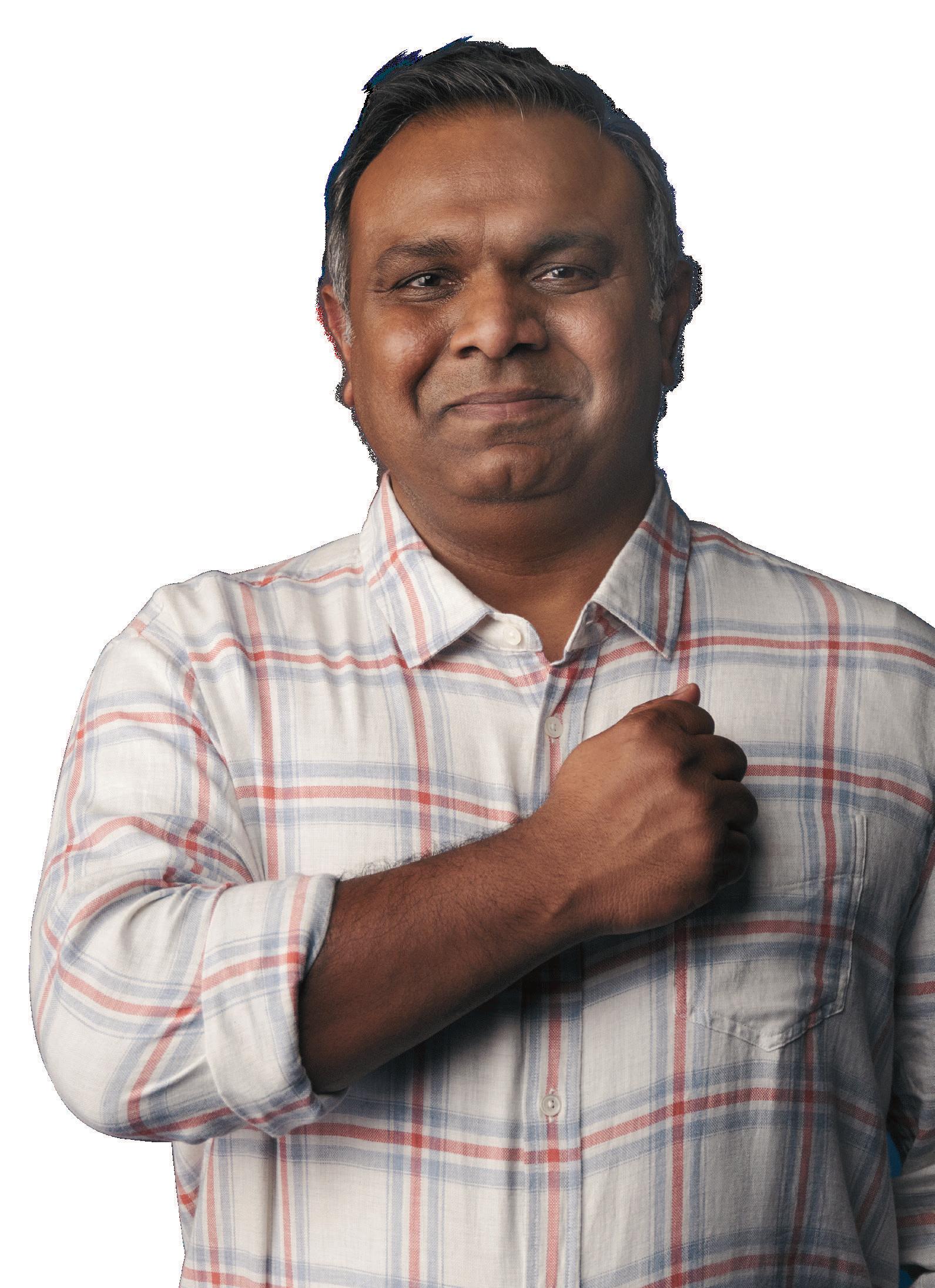
A WOMAN’S GUIDE TO BETTER HEALTH NEW WAYS TO FIGHT LUNG CANCER
KIDNEY DONORS SAVE LIVES
140 POUNDS LOST WHAT FINALLY WORKED
HealingHearts WITH ADVANCED IMAGING


A WOMAN’S GUIDE TO BETTER HEALTH NEW WAYS TO FIGHT LUNG CANCER
KIDNEY DONORS SAVE LIVES
140 POUNDS LOST WHAT FINALLY WORKED
HealingHearts WITH ADVANCED IMAGING
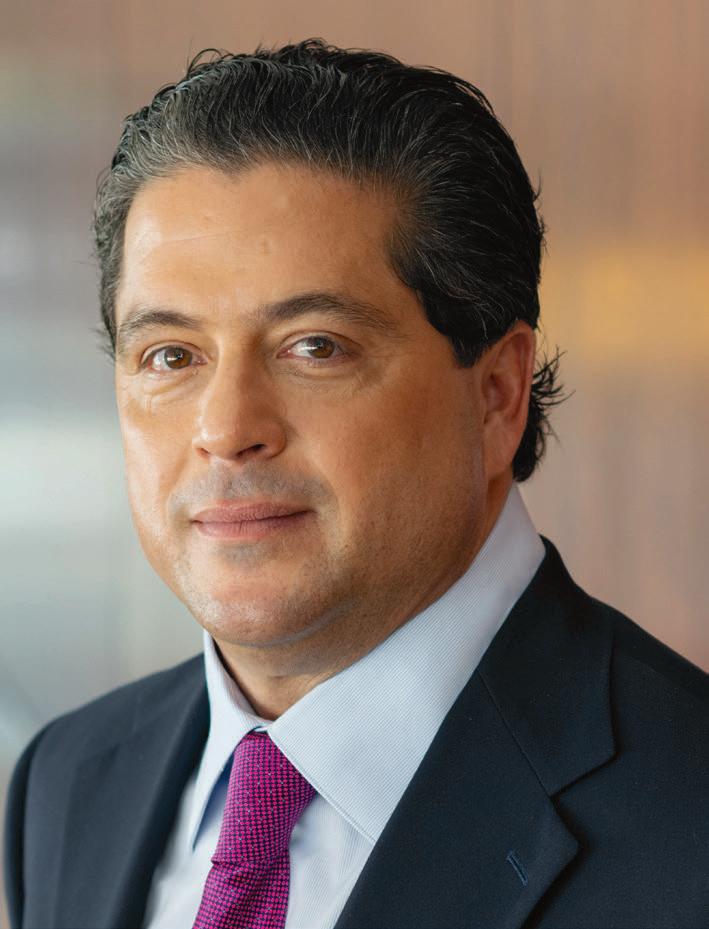
RWJBarnabas Health is proud to collaborate with like-minded organizations in pursuit of our noble mission to build and sustain healthier communities. We are pleased to announce that we are strengthening our long-standing partnership with the New Jersey Devils to expand our shared vision to support active and healthy lifestyles across our great state.
As a symbol of our shared commitment, the RWJBarnabas Health logo will be featured on all Devils home jerseys as we become the club’s first-ever patch partner.
Details of this remarkable partnership are in the pages that follow. While we will continue to provide world-class care to professional athletes, of equal importance are the community-based health initiatives that will be enhanced through our partnership with the Devils.
Together, we have developed hockey rinks through joint programs, 15 of which offer Learn to Play programs to introduce youth to hockey. More than 115 teams and organizations now play at the RWJBarnabas Health Hockey House in Newark, and RWJBarnabas Health’s combined blood drives with the Devils have resulted in 368 units of critical, lifesaving donations.
We look forward to our continued work with the Devils to benefit the residents of New Jersey and beyond. On behalf of my 41,000 terrific colleagues, I thank you for entrusting RWJBarnabas Health with the privilege of caring for you and your family.
Sincerely,
MARK E. MANIGAN PRESIDENT AND CHIEF EXECUTIVE OFFICERRWJBarnabas Health complies with applicable federal civil rights laws and does not discriminate on the basis of race, color, national origin, age, disability or sex. For more information, see the link on our home page at www.rwjbh.org.
RWJBarnabas Health provides free language services, including qualified interpreters, to people whose primary language is not English. The following Language Assistance Services information is provided in multiple languages.
ESPAÑOL
ATENCIÓN: Si habla español, tiene a su disposición servicios gratuitos de asistencia lingüística.
Llame al 1.844.465.9474
繁體中文
注意:如果您使用繁體中文,您可以免費 獲得語言援助服務。
致电1.844.465.9474
한국어
주의: 한국어를 사용하시는 경우, 언어 지원 서비스를 무료로 이용하실 수 있습니다. 1.844.465.9474 로 전화하십시오.
PORTUGUÊS
ATENÇÃO: Se fala português, encontram-se disponíveis serviços linguísticos, grátis. Ligue para 1.844.465.9474
ગુજરાતી
સુચના: જો તમે ગુજરાતી બોલતા હો, તો નિ:શુલ્ક ભાષા સહાય સેવાઓ
POLSKI
UWAGA: Jeżeli mówisz po polsku, możesz skorzystać z bezpłatnej pomocy językowej. Zadzwoń pod numer 1.844.465.9474
ITALIANO
ATTENZIONE: In caso la lingua parlata sia l’italiano, sono disponibili servizi di assistenza linguistica gratuiti. Chiamata 1.844.465.9474
@RWJBarnabasHealth
@RWJBarnabas
RWJBarnabas Health
RWJBarnabas_Health
linkedin.com/company/
RWJBarnabasHealth
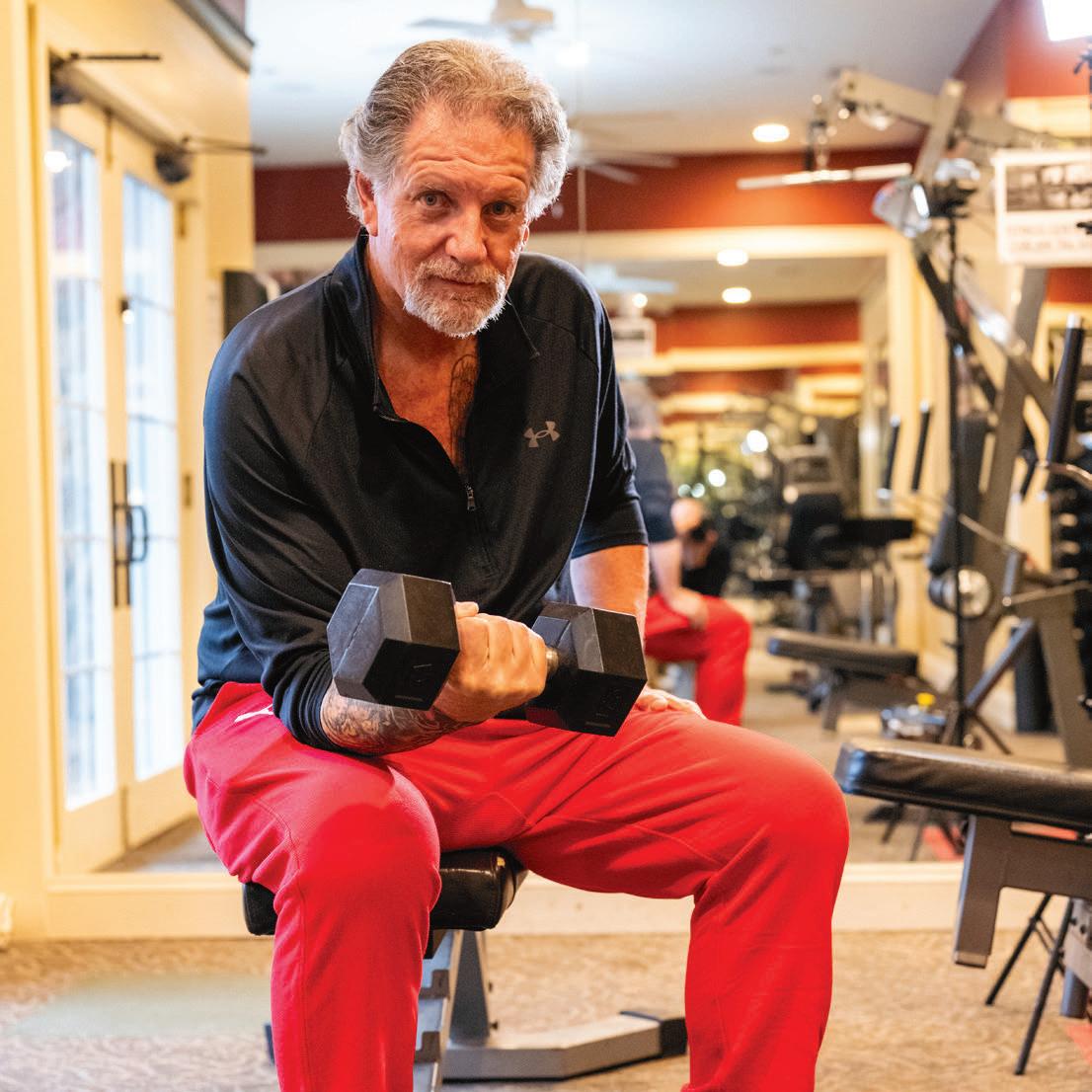
2. WELCOME LETTER. A community update from our President and Chief Executive Officer.
4. COMPASSION IN A CRISIS. Behavioral health screeners pair with law enforcement.
5. QUIT SMOKING FOR GOOD. A free program boosts the chances of success.
6. COLLABORATING FOR A CURE. Pediatric specialists resolve a child’s urological condition.
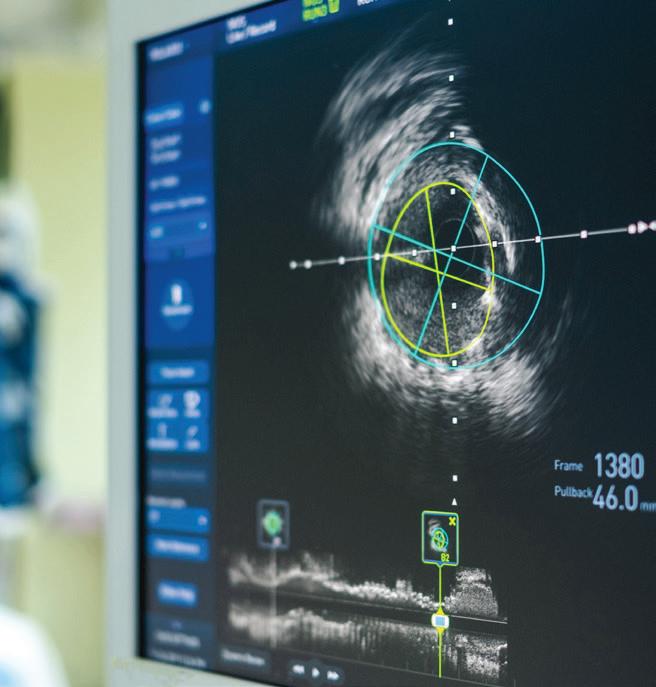
8. NEW WEIGHT, NEW LIFE. Lifestyle changes and a transformative surgery help a man lose 140 pounds.


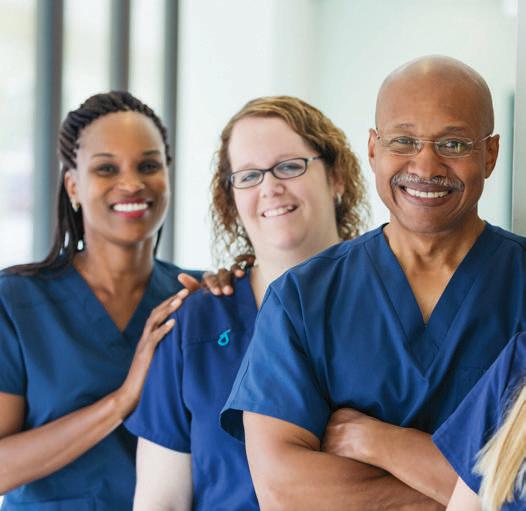
10. “THEY GAVE ME MY LIFE BACK.” A community partnership makes a double knee replacement surgery possible.
12. SAFEGUARD YOUR HEALTH IN EVERY DECADE. A woman’s guide to improving well-being.
14. MAKING GREAT CATCHES. Cardiac imaging that pinpoints problems early saves lives.
16. NEW STRIDES IN LUNG CANCER TREATMENT. Outcomes can improve through early detection, advanced technology and a team approach.


18. AN EXPANDED PARTNERSHIP. RWJBarnabas Health and the New Jersey Devils tighten a 30-year bond.
20. MAKING NURSING STRONGER. How a new institute supports providers and improves patient care.
22. AN UNBREAKABLE BOND. Two brothers strengthen their connection through the transplant of a donated kidney.


It often begins with a 911 call from a family member. In many cases, a loved one who has been diagnosed with a serious mental illness has stopped taking medication and/or is exhibiting concerning behaviors. Often the person is acting erratically or has withdrawn from others and can’t be convinced to seek care or go to a hospital. The family member may be concerned about the loved one’s safety—or their own.
Such situations carry a heightened risk of escalating and requiring the use of force—or even triggering violence—when police respond with lights and sirens. But a new state-funded program through New Jersey’s Office of the Attorney General has helped people get the care they need in ways that are likelier to be effective, compassionate and safe.
The initiative is called ARRIVE Together, using an acronym for Alternative Responses to Reduce Instances of Violence and Escalation. It began as a co-response program with a plainclothes, Crisis Intervention Team-trained law enforcement officer responding to calls together with a certified New Jersey mental health screener such as those available through RWJBarnabas Health (RWJBH) Behavioral Health Services, with the two arriving in an unmarked car.
The certified screener assesses the crisis and determines whether the
person requires hospitalization or a more thorough evaluation at a mental health screening center.
If the person in crisis needs further care, the certified screener engages the person to go voluntarily or, if necessary, arranges for involuntary transport. When the person does not pose an imminent danger, the screener provides referrals to communitybased support services that could help.
“It’s important to provide the right environment to speak with the patient and family,” says Frank Ghinassi, PhD, Senior Vice President of Behavioral Health Services at RWJBH and President and Chief Executive Officer of Rutgers University Behavioral Health Care. “We need to conduct a thorough assessment in a nonthreatening environment where the patient understands that we are there to support them and their health status, not to arrest them.”
Together partnerships and flexibility in tailoring solutions to community needs, the program successfully extended its reach to all 21 counties in New Jersey within a twoyear time frame. ARRIVE Together is in place throughout the RWJBH system.
The program came to Monmouth County in early 2024, with RWJBH Behavioral Health screeners working in partnership with the Monmouth County Prosecutor’s Office and utilizing both the county’s Sheriff’s Department and the Long Branch Police Department.
“ARRIVE Together guarantees a response in a less threatening and more therapeutic manner,” says Joe Cuffari, LPC, Vice President, Psychiatric Emergency Services at RWJBH. “It not only keeps members of the community safer— including the patient, the family, the law enforcement officer and the screener—but also in many cases can link people to resources without ever bringing them to a hospital.”
To learn more about behavioral health services, visit www.rwjbh.org/behavioralhealth
ARRIVE Together has rolled out gradually across the state since its founding in December 2021. The initiative has expanded its scope by incorporating additional models tailored to address the specific needs of communities, taking into account their available resources. These models encompass a telehealth initiative, a follow-up protocol and a proactive engagement strategy, particularly implemented at various NJ Transit locations across the state. Through ARRIVE
“Through the synergy of law enforcement, mental health professionals like our partners at RWJBarnabas Health Behavioral Health Services and the community, ARRIVE Together stands as a testament to the boundless potential of collaboration to best serve the needs of our communities,” says Attorney General Matthew J. Platkin. “This first-of-itskind statewide initiative demonstrates the transformative power of partnership, reshaping public safety while redefining the realm of achievable possibilities in providing essential mental health services to every corner of our state.”
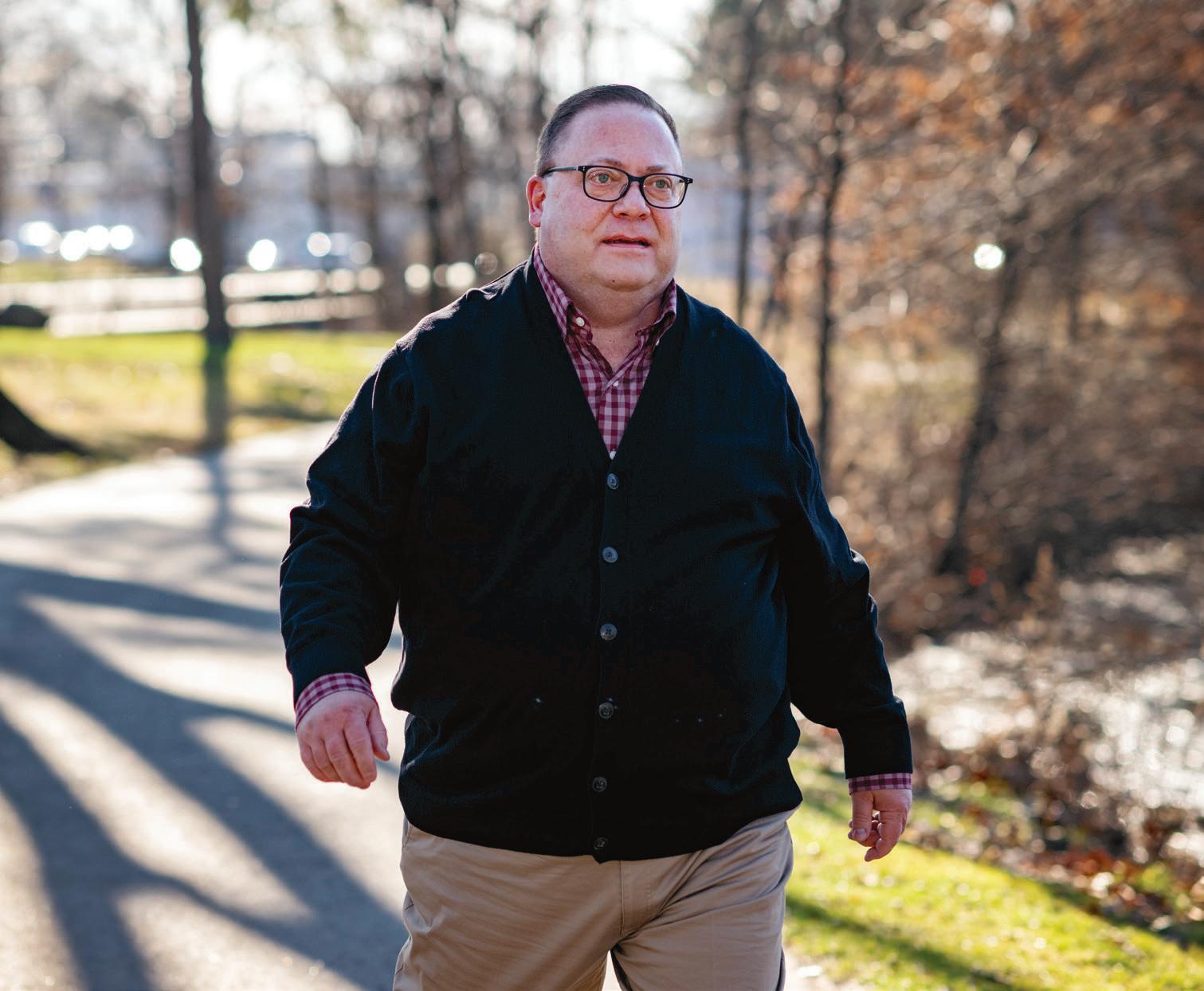
A FREE PROGRAM AVAILABLE THROUGHOUT RWJBARNABAS HEALTH CAN BOOST THE CHANCES OF SUCCESS.
Giving up smoking is notoriously difficult. But a program through the Institute for Prevention and Recovery (IFPR) at RWJBarnabas Health (RWJBH) can help. Called the Nicotine and Tobacco Recovery Program, the initiative gives smokers hope that they can live healthier lives—and provides tools that lead to lasting success.
Frank Huelster is an example of what program participants can achieve. The 57-year-old Linden resident had smoked since he was about 13. When he finally decided to quit, he was smoking a pack and a half to two packs daily.
“Quitting was about my health,” Frank says. “I was having problems breathing. Even walking up six steps left me exhausted.” He had looked into the
Nicotine and Tobacco Recovery Program but hesitated to join.
“I was concerned that it was going to be difficult, that I would not follow through and that it would be a failure,” he says. “You make all kinds of excuses and have an argument with your own brain about the right path.”
He finally dropped into an online group meeting. “I really liked the way it was set up,” he says. “I thought, ‘Yeah, this is the time. I’ve got to do it.’”
The state-funded program—available free throughout the RWJBH system— recognizes the difficulties of smoking cessation, including concerns and stresses that can hold people back.
“We meet people where they are,” says Monica Hanna, MPH, CHES, NCTTP, the Nicotine and Tobacco Recovery Program’s assistant director. “We understand patient needs, break the stigma of addiction and provide support for years to make sure people have tools to prevent relapse.”
A team-based, multifaceted approach mixes group support, coping strategies, stress and weight management, medications (usually combination therapies delivered directly to participants’ homes) and long-term follow-up.
“Of the 70 percent of smokers who want to quit, only 5 to 7 percent are successful on their own,” Hanna says. “But when people join our program, success rates can double or even triple, depending on the patients’ readiness to quit and the integration of behavioral modification techniques.”
Frank especially valued the encouragement and guidance he received in group meetings, which can be attended in eight-week sessions or indefinitely for ongoing support.
Group members helped him get back on track when he relapsed one night. “I woke the next day feeling terrible about myself,” Frank says. The group kept him accountable. “I felt an obligation to be truthful,” he says.
The group and its leader, certified tobacco treatment specialist Mariana Gomez, didn’t judge. “They were all so supportive,” Frank says. “What happened yesterday doesn’t affect what happens today or tomorrow. Since then, I haven’t had a single cigarette.”
That was two years ago. Frank now feels healthier, breathes better and has more confidence. “It’s one of the more difficult things I’ve had to do,” he says. “I really feel I accomplished something.”
To learn more about Institute for Prevention and Recovery programs available across New Jersey, visit www.rwjbh.org/preventionandrecovery
Frank Huelster had been a smoker since age 13 but successfully quit two years ago with support from the Nicotine and Tobacco Recovery Program.Surgery helped Stephanie Savanchuk (far right) protect her kidneys, supported by (from left) her father, Petro; brother, Ivan; and mother, Halyna.
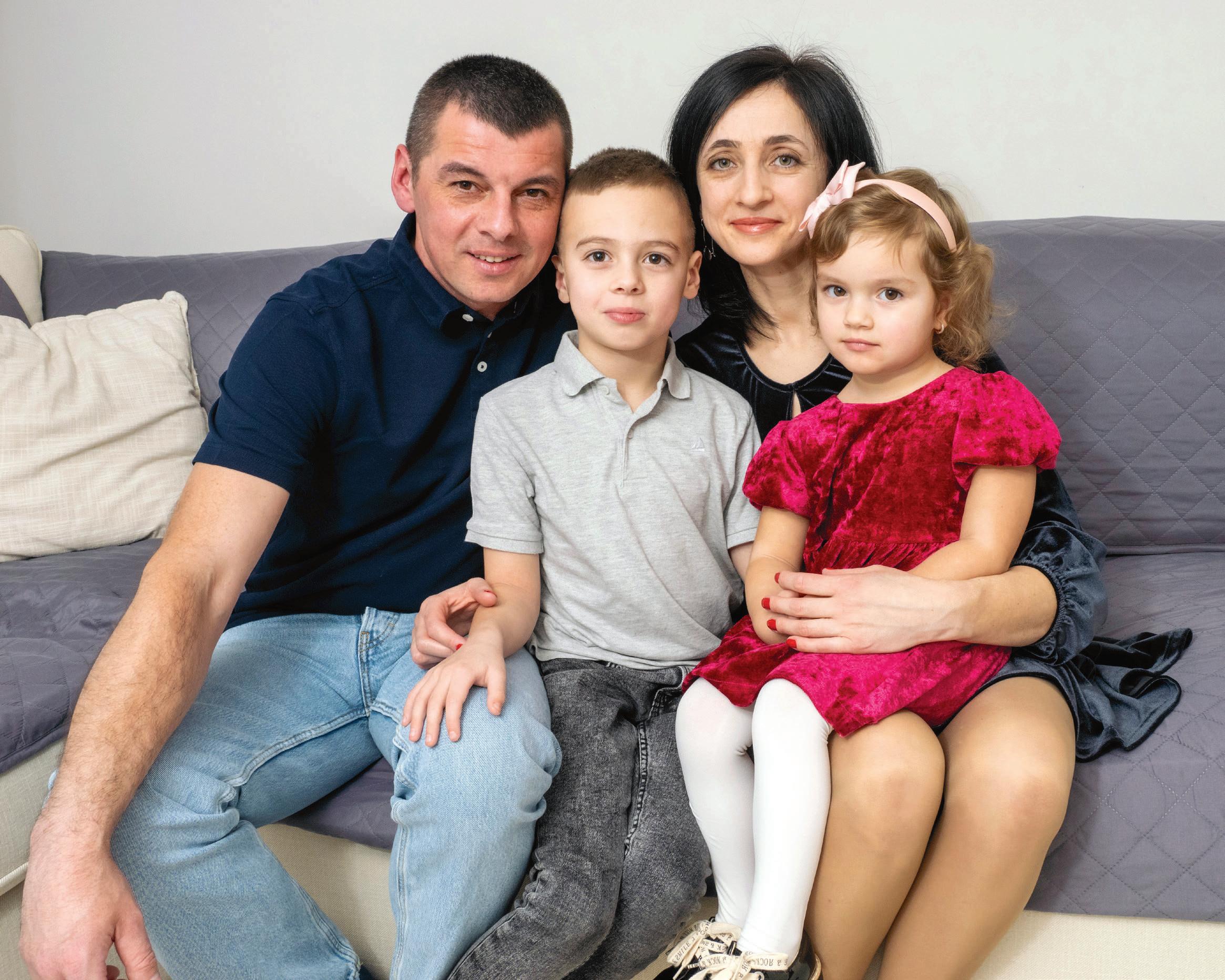
WHEN A CHILD DEVELOPED A SERIOUS UROLOGICAL CONDITION, PEDIATRIC SPECIALISTS TEAMED UP TO FIND THE BEST TREATMENT.
Learning that your child has a serious medical condition is a parent’s worst nightmare. But for Petro and Halyna Savanchuk of Scotch Plains, the news was tempered with hope.
When a pregnancy ultrasound suggested that their daughter, Stephanie, had a dilated urinary tract system, a common urological problem that could be secondary to various conditions,
they learned she had a good chance of outgrowing the issue with little intervention. If that turned out not to be the case, expert pediatric nephrology and urology teams at RWJBarnabas Health (RWJBH) Children’s Health network would be able to help.
After her birth, Stephanie had an abnormal backflow of urine from the bladder up one or both of the ureters— the tubes that connect the kidneys to the bladder. (Normally, urine flows from the kidneys to the bladder before exiting the body.) The condition is most common in infants and young children.
“With this condition, the valve mechanism that prevents urine from shooting back toward the kidneys is faulty,” says pediatric urologist Haris S. Ahmed, MD, Co-Chief of the Robotic Surgery Program at The Bristol-Myers Squibb Children’s Hospital (BMSCH) at Robert Wood Johnson University Hospital in New Brunswick. “That can allow urine to back up to the kidneys, which can damage them.”
Although most affected children grow out of the problem, it became clear over time that Stephanie wasn’t going to be among the fortunate majority.
Doctors had first known something was wrong because Stephanie’s left kidney showed signs of hydronephrosis, a condition that occurs when one or both kidneys become stretched and dilated because urine has built up inside them.
When Stephanie was 2 months old, the Savanchuks met with pediatric nephrologist M. Isabel Roberti, MD, PhD, Director of the Children’s Kidney Center at Cooperman Barnabas Medical Center (CBMC), to discuss the problem. A procedure called a cystogram confirmed the reflux diagnosis.
Stephanie’s case was grade 5, which indicates greater severity. “You follow patients at this level closely,” Dr. Roberti says. “If the dilatation remains, patients often need surgery.”
Another factor to weigh was Stephanie’s kidney function. “The right kidney worked 71 percent,” remembers Petro. “But the left kidney was only 29 percent. At the time, it was not a big problem because both kidneys were adequately clearing waste products. But we didn’t know what the future would hold.”
A multidisciplinary team of RWJBH providers considered the complex variety of factors and consulted with one
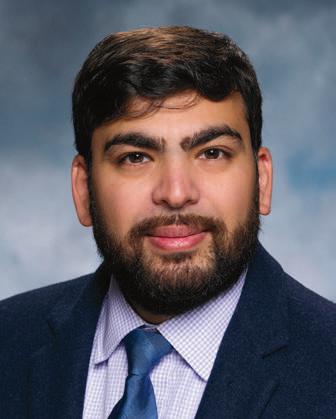
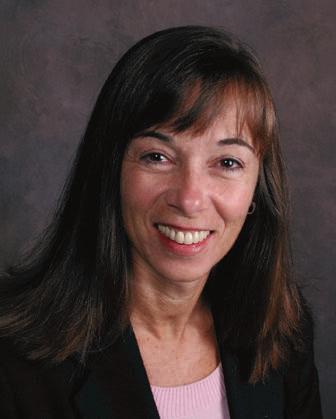
another to determine the best course of action as Stephanie’s condition evolved.
“The collaboration is immediate,” says Dr. Roberti. “If I have a serious case, I can text Dr. Ahmed and he replies right away. We work very closely together.”
RWJBH providers have access to a large and varied network of specialists who are able to bring their capabilities to bear on a given patient’s care. The system’s children’s hospitals were named among the nation’s Best Children’s Hospitals for 2023-2024 by U.S. News & World Report, with BMSCH ranking 47th for urology. The urology ranking recognizes a four-hospital practice that is based at BMSCH but also provides care at three other RWJBH hospitals: Children’s Hospital of New Jersey at Newark Beth Israel Medical Center, McMullen Children’s Center at CBMC and Unterberg Children’s Hospital at Monmouth Medical Center. Similarly, pediatric nephrology care is offered systemwide.
“That breadth and depth of expertise is something we offer that not many places do,” says Dr. Ahmed.
“It’s important to receive care in a center where doctors work together in order to prevent any complications and in general facilitate the care of the child,” Dr. Roberti adds.
After Stephanie turned 18 months, her situation came into sharper focus. “She’d had recurrent febrile urinary tract infections [UTIs], which are severe UTIs that have been shown to cause scarring of the kidneys,” says Dr. Ahmed. “When a patient is on a suppressive antibiotic to prevent UTIs, it means a UTI that occurs is all the more severe because it managed to break through the antibiotic.”
Dr. Roberti and Dr. Ahmed began to talk seriously about surgery to reposition Stephanie’s ureter in a way that would prevent urine from backing up during
urination and entering the kidney. “We didn’t want to risk further kidney damage,” Dr. Ahmed says.
As with specialized pediatric urology and nephrology care, pediatric surgery is available throughout the RWJBH system, giving Stephanie access to a robotic procedure performed by some of the most experienced pediatric surgeons in New Jersey. The RWJBH pediatric robotic surgery program is the first of its kind in the state to be accredited.
Robotic surgery is performed through small incisions using instruments that the surgeon controls from a console. The system can maneuver into hard-to-reach places and greatly magnifies the surgeon’s field of vision. Patients usually spend no more than a night in the hospital, and recovery time is short.
“It’s not very common to do this procedure in young kids,” says Dr. Ahmed. “The smaller a child is, the more challenging it is to do robotic surgery because the space inside the abdomen is limited. But this is something we specialize in.”
The alternative would be to make a larger abdominal incision and cut through muscles. Patients getting this traditional type of surgery usually have a three- or four-day hospital stay and a longer, more painful recovery.
On the day of surgery, Petro and Halyna were nervous and worried. While the procedure itself took about two hours, “We didn’t see our daughter for a few hours,” Petro says. “It was so hard to wait. I’ll never forget that day.”
But Stephanie did well—and has thrived since.
“Her condition is now in the rearview mirror,” says Dr. Ahmed. “Her reflux was cured, and she has not had any additional UTIs.”
“I’m thankful for the doctors and nurses who helped my daughter,” says Petro. “Her health problem was very stressful for us, but that’s all gone now— because she’s OK.”
Exercises such as lifting weights, walking on a treadmill and pedaling a bike are among the healthy habits that help Walter O’Neill sustain his weight loss.
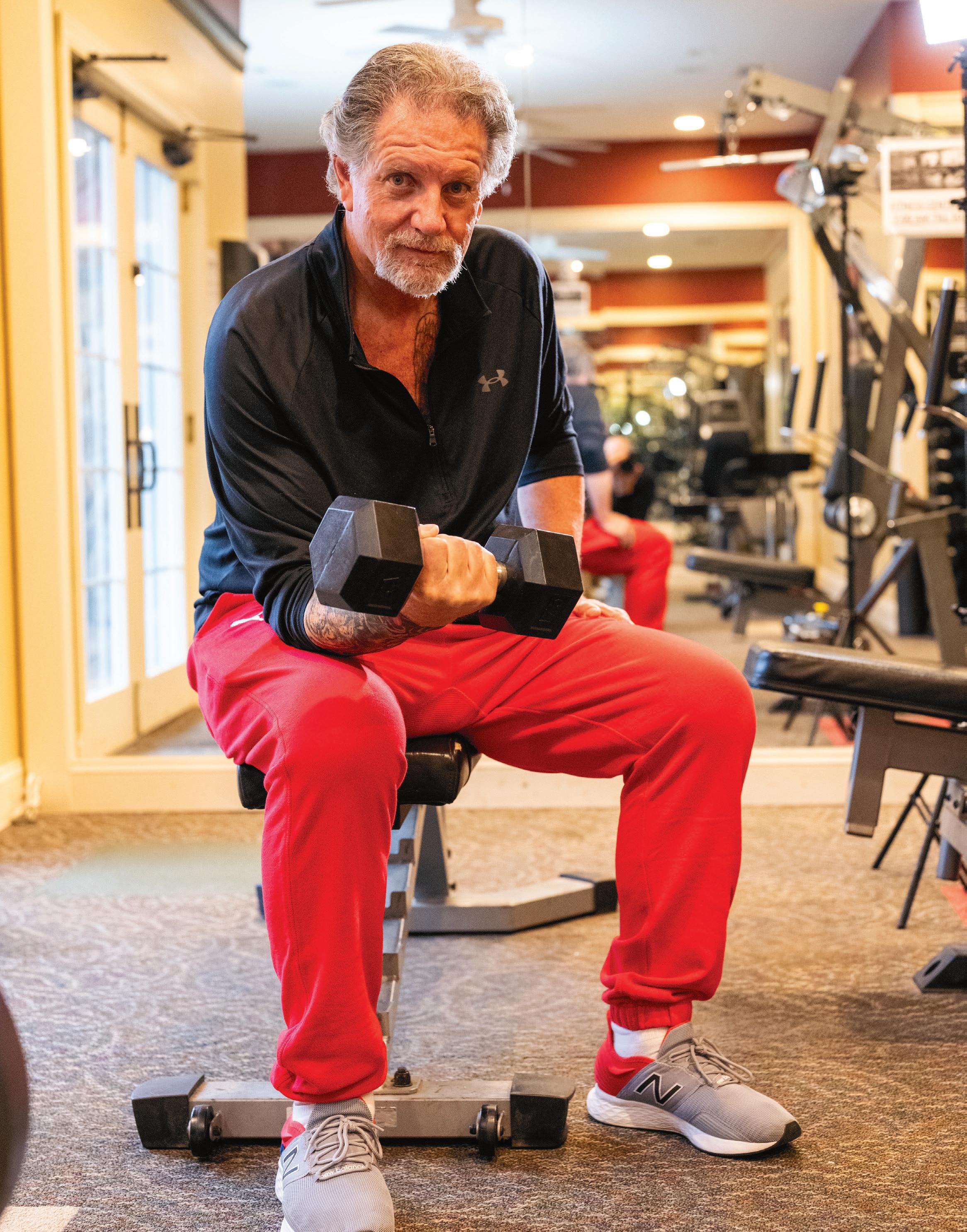
A
Aknee injury back in 1987 had set off a devastating snowball effect for Walter (Walt) O’Neill. First it ended his careers as both a police officer and a winning athlete. Then the five-time national champion and all-American in karate steadily gained weight over the decades that followed, which included 27 knee surgeries that eventually allowed him to become more mobile.
Seeking comfort in eating, Walt, who stands 6 feet, 2 inches, grew to well over 300 pounds. “It was all unhealthy foods and bad eating habits,” the Ocean Township resident recalls. “I was eating lots of fried food, often late at night, and getting no vegetables. And I wasn’t listening to people who cared about me and who told me to stop.”
Even a near-fatal “widow-maker” heart attack in 2016—caused by a complete blockage of the heart’s largest artery—didn’t turn Walt’s habits around. He tried dieting, but nothing stuck for long. “I kept slipping back to my old habits and forgetting why I was trying to get healthy,” he says.
It took another six years before Walt was jolted into realizing his weight was preventing him from living not only a healthy life, but also a fulfilling one. During a trip to an amusement park with two young granddaughters in summer 2022, a park employee told Walt that he was too large to fit on a ride with one of them and had to get off.
“I let my granddaughter down, and I let myself down,” says Walt, now 64. “I should never have let myself be in that situation. I was 360 pounds.”
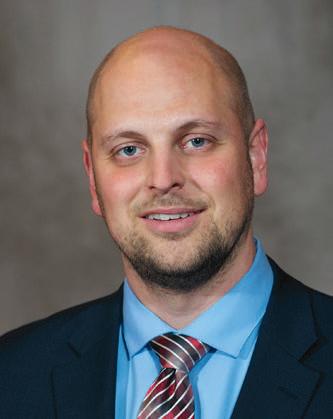
As soon as Walt got back to his hotel, he started plotting a healthier course. A major part of it, he decided, would be to undergo bariatric, or weight
loss, surgery.
When he consulted with Michael Jaronczyk, MD, a member of the Weight Loss and Bariatric Surgery team at Monmouth Medical Center and Community Medical Center, Walt already had a procedure in mind. He wanted a sleeve gastrectomy, which removes about 80 percent of the stomach and leaves a tubular “sleeve” about the size of a banana. The procedure is the most commonly performed weight loss surgery in the United States.
Dr. Jaronczyk readily agreed that bariatric surgery made sense for Walt, and the pair hit it off. “Patients do very well with the gastric sleeve since it makes you feel fuller sooner, but most of the results are due to hard work,” says Dr. Jaronczyk. “Surgery is a tool we give patients to be successful along with dieting and exercise, but surgery doesn’t work without those lifestyle efforts.”
Walt had to commit to several presurgical requirements. One was to work with a registered dietitian to lose at least 20 pounds. He also agreed to stop smoking cigars and give up caffeinated drinks and sugar. And he underwent a thorough medical workup.
Walt further attended support group meetings that offered tips and insights to help him transform his body and lifestyle. “In order to be successful, you need to be around people who have gone through it,” he says.
About three weeks before his surgery, Walt took care of another crucial task: telling his family about his plans. He heard nothing but encouragement. “My wife, Patty, said it was the best decision she ever heard me make,” he says.
Walt underwent his bariatric procedure in February 2023 without any complications. Dr. Jaronczyk used
a leading-edge device called a Titan stapler—which staples the newly created stomach sleeve shut “in one shot”—to complete the minimally invasive operation.
When Walt awakened, he was surprised to feel “no pain whatsoever” and proceeded to walk around the hospital hallways for about an hour. He went home the next morning.
Walt’s weight dropped quickly after surgery as he progressed from clear liquids to soft foods and then to a new-normal eating pattern. He learned to eat far smaller portions and to consume meals much more slowly. And he found he no longer craved foods that used to tempt him.
“I could eat a whole pizza before surgery,” he says. “Now I don’t even want a slice. Instead of potato chips, I eat carrots. A lot has to do with the fact that I don’t want to go back to the size I was.”
Regular exercise includes walking on a treadmill, pedaling a bike and lifting weights. “When you’re lighter and nothing hurts, it feels like you can do everything again,” he says.
Dr. Jaronczyk describes Walt as a model patient. “He really hit the ground running,” he says. “Walt has been an all-star patient the whole way. He’s setting the bar for others.”
Now 140 pounds lighter, Walt is adjusting to his new size and relishes moving around with no pain. He loves how weight loss has allowed him to stop taking all prior medications except baby aspirin for his heart.
The head of security for a local school district, Walt envisions returning with his grandchildren to the amusement park—where he’ll easily be able to accompany them on rides.
A COMMUNITY PARTNERSHIP MAKES DOUBLE KNEE REPLACEMENT SURGERY POSSIBLE FOR A MANALAPAN WOMAN.

As a busy real estate agent and the single mom of two daughters and a son, JoAnna Maietta is used to taking care of everyone else. But when it comes to taking care of her own health, “I’m
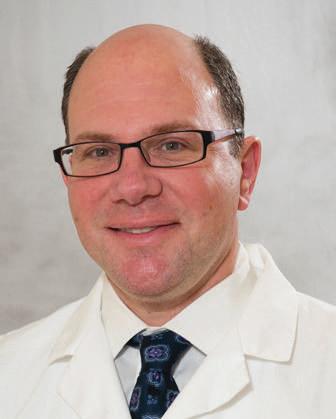
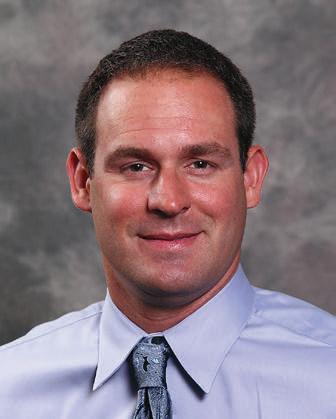
pretty good at putting my head in the sand and saying, ‘I’ll get to it tomorrow,’” the Manalapan resident says.

For four years, JoAnna lived with excruciating pain in both of her knees. “There was a constant grinding, cracking, rubbing and burning,” she says. Showing houses to potential buyers became a serious challenge. “My clients would be on the second floor, and
I’d still be climbing up the stairs from the basement,” JoAnna says. “It was embarrassing.”
Still, JoAnna tried to soldier on. She thought she was hiding her pain well. Then, one day, her youngest daughter looked up and said, “Mom, it’s painful to watch you walk.”
“That,” JoAnna says, “was hard to hear.”
JoAnna’s knee arthritis had become so bad that her knees began to bow, and she shrank 3 inches in height. Eventually, she had to stop working, losing her only source of income. “I didn’t have health insurance—I couldn’t
DAVID CHALNICK, MD

Scan this code to watch a video chronicling JoAnna Maietta’s life-changing experience. The video also features Miadea Esther Constance Ganda, a 70-year-old woman from upstate New York who received total joint replacement surgery on her ailing left knee. Through Operation Walk USA, Joel Fechisin, MD, a board-certified, fellowship-trained orthopedic surgeon with Seaview Orthopaedics, performed Miadea’s surgery at Monmouth Medical Center (MMC), with rehabilitation services donated by JAG Physical Therapy.
“Monmouth Medical Center is proud to participate in Operation Walk USA and offer these services at no charge as part of our efforts to give back to the communities we serve,” says Eric Carney, President and CEO of MMC and MMC Southern Campus in Lakewood. “We are grateful to our surgeons and our partners for their generosity, providing two patients with the tremendous gift of renewed health and improved mobility.”
“Joint replacement can be lifechanging, allowing patients to get back to their active lifestyles,” says David Chalnick, MD, Medical Director of MMC’s Joint Replacement Surgery Program and a board-certified, fellowship-trained orthopedic surgeon with Seaview. “Through Operation Walk USA, we wanted to help those without health insurance who otherwise would not have the opportunity to get that new lease on life.”
While many patients supported by Operation Walk USA need single joint replacement surgery, JoAnna’s situation was unusual. “She had severe bilateral knee arthritis and could barely walk five feet without significant pain,” explains Arthur Mark, MD, a board-certified, fellowship-trained orthopedic surgeon who worked with JoAnna.
Dr. Mark asked JoAnna if she wanted to have both knees replaced in the same procedure, and JoAnna agreed.
On December 11, Dr. Mark performed the dual knee replacement surgeries at MMC pro bono and MMC offered the hospital’s services free of charge. Zimmer Biomet donated the implants for the surgery, and Seaview provided free physical therapy.
afford it; I couldn’t walk without pain; and I was suffering in silence,” she says. “I felt helpless.”
JoAnna found a glimmer of hope in May 2023 when she shared her story with a cousin at a family barbecue. Her cousin sent JoAnna a few internet links, including one to Operation Walk USA, an organization that arranges free joint replacement surgeries for people in need. Operation Walk USA has connected more than 860 people without health insurance to orthopedic surgeons who can provide care—including
surgeons at Seaview Orthopaedics in Freehold, a partner medical practice of RWJBarnabas Health, and Monmouth Medical Center (MMC) in Long Branch.
JoAnna reached out to the organization, and on September 25— one day before her 58th birthday—she received a phone call that would change her life. “It was Operation Walk USA, and they asked if I could be at Seaview the next day—on my birthday,” she says. “I saw that as a sign this was meant to be.”
Seaview and MMC had joined forces with Operation Walk USA to give two patients free joint replacement surgeries—and JoAnna would be one of them (see sidebar).
JoAnna was up and walking the day of her surgery and returned home three days later. “The experience at MMC was wonderful from start to finish—everyone from the valet parking guy all the way up to my doctors,” she says. “I had a room with a beautiful view of the beach. I didn’t want to go home!”
Today, JoAnna is regaining strength and looking forward to restarting her 23-year real estate career. She’s grateful for everyone who got her past a frustrating period. “Thanks to Operation Walk USA, that time is over,” she says.
“A story like this is almost too good to be true,” she says. “People jumped through hoops for me. It just blew me away. They gave me my life back.”
To learn more about joint replacement surgery at RWJBarnabas Health, visit www.rwjbh.org/ortho
JoAnna Maietta smiles on the day of her double knee replacement surgery at Monmouth Medical Center.
A WOMAN’S GUIDE TO KEY SCREENINGS AND OTHER STEPS THAT CAN IMPROVE WELLBEING THROUGHOUT LIFE
Women’s health concerns often focus on milestones such as pregnancy, childbirth and menopause. But day-to-day and year-toyear health maintenance and preventive measures are also critical to well-being throughout life.
“Getting recommended exams, screenings and immunizations are some of the most important things you can do to prevent problems or catch them earlier, and stay healthier longer,” says Suzanne Spernal, DNP, APN-BC, RNCOB, C-ONQS, Senior Vice President of Women’s Services at RWJBarnabas Health. “Maintaining a healthy weight throughout the life span is also key to living healthy.”
Here are vital steps to take—and details on when to take them— throughout a woman’s adult life.
in EACH DECADE
Working with your healthcare provider to keep on top of regular tests and practices throughout life can have long-term benefits by detecting or monitoring chronic conditions that, left unchecked, often snowball into potentially serious problems.
• Full checkup: See a primary care provider yearly.
• Sleep habits: Discuss at your annual exam.
• Thyroid (TSH) test: Discuss with your healthcare provider.
• HIV screening: Get tested if you are at risk for HIV infection (due to, for example, unprotected sex, sexually transmitted disease or use of drugs with needles).
• Blood pressure test: Get one at least every two years if not at your annual checkup.
• Cholesterol panel: Establish your total, LDL, HDL and triglycerides in your 20s. Discuss follow-up with your provider in subsequent years.
• Blood glucose or A1C test: Get screened if you have sustained blood pressure greater than 135/80, take medicine for high blood pressure or are at risk of developing diabetes.
• Skin exam: Do a self-exam of skin and moles monthly and as part of a routine full checkup.
• Dental cleaning and exam: See your dentist twice yearly.
• Behavioral health screening: Talk with your provider about whether this would be helpful.

in your 20s and 30s Early adulthood is the time to establish a baseline of regular self-checks, exams and screenings that you can build on in the decades to come. You’ll continue many of these practices as you age.
• Breast self-exam: Regularly examine your breasts and become familiar with them so you can identify any changes and discuss them with your provider.
• Clinical breast exam: Have a provider check your breasts at least every three years.
• Pap test: Undergo screening for cervical cancer at least every three years.
• Pelvic exam: See your obstetriciangynecologist yearly beginning at age 21.
• Sexually transmitted infection (STI) tests: Both partners should get tested for STIs, including HIV, before initiating sexual intercourse. Get a
chlamydia test yearly until age 24 if you are sexually active. After age 25, continue getting this test yearly if you have new or multiple partners.
• Seasonal influenza vaccine: Get your shot yearly.
• COVID-19: Keep up to date with boosters.
• Tetanus-diphtheria-pertussis booster vaccine: Update every 10 years.
• Human papillomavirus (HPV) vaccine: Protect against HPV with a single twodose series up to age 26; if your vaccine series is incomplete, talk with your provider.
• Meningococcal vaccine: Discuss with your provider if you are in college or in the military.
50s
Continue following recommendations from your 20s and 30s for breast and reproductive health or discuss with your doctor, and keep up with recommended immunizations. Add the following.
• Bone density screening: Talk with your provider about guarding against bone conditions such as osteoporosis.
• Mammogram: Get yearly screening mammograms beginning at age 40.
• Comprehensive eye exam: If you haven’t already done so, see an eye doctor for a baseline exam at age 40, then every two to four years as your doctor advises. At age 55, start getting eye exams every one to two years.
• Hearing test: Have your hearing tested in your 40s. Retest after 10 years, then every three years from your 50s on.
• Fecal occult blood test, flexible sigmoidoscopy, colonoscopy: Starting at age 45, get screened for colorectal cancer. Talk with your provider about
which screening test is best for you and how often you need it.
• Hepatitis C (HCV) screening: Get this onetime screening in your 50s if you were born between 1945 and 1965.
in your 60s, 70s and BEYOND
Continue following recommendations from your 40s and 50s for breast, reproductive, colorectal and eye/ear health, and keep receiving scheduled immunizations. Address the following considerations.
• Hepatitis C (HCV) screening: If you haven’t already been screened for hepatitis C and were born between 1945 and 1965, get your test.
• Mammogram: Continue screening annually through age 74; discuss with your provider from age 75 on.
• Pap test: Discuss continued testing with your provider.
• Bone density screening: If you haven’t yet had a bone mineral test, get it at least once, ideally by around age 65. Talk with your provider about repeat testing.
• Pneumococcal vaccine: Get this onetime vaccine to protect against pneumococcal disease.
• Herpes zoster vaccine: Talk with your provider about preventing shingles and painful complications with a onetime, two-shot series.
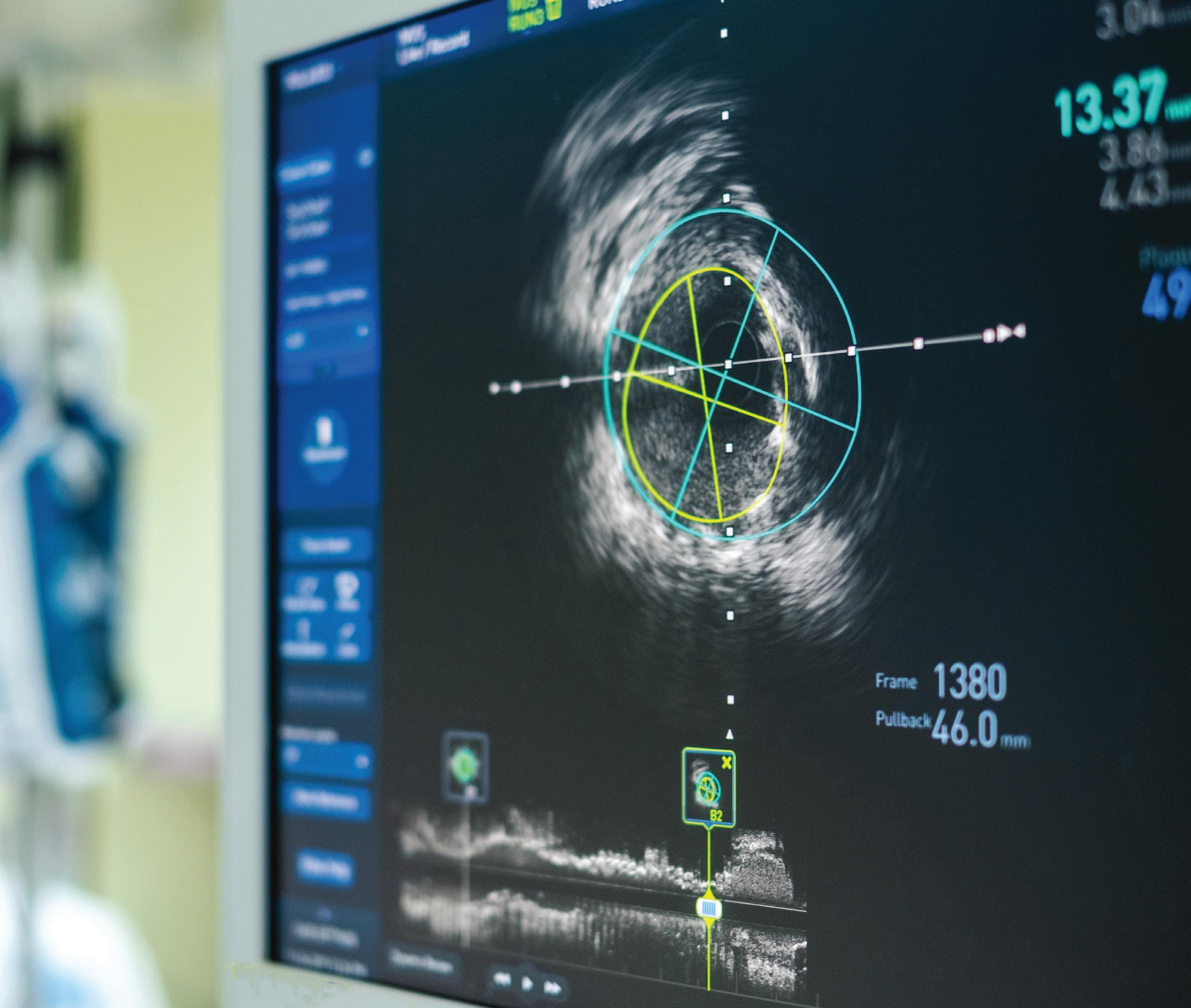
Many patients schedule regular mammograms and colonoscopies to screen for cancer, but don’t think of taking the same approach for the heart. That perspective is changing due to ever more sophisticated screening technologies at RWJBarnabas Health (RWJBH), New Jersey’s largest network of noninvasive, advanced cardiovascular imaging centers.
Cardiovascular screenings can
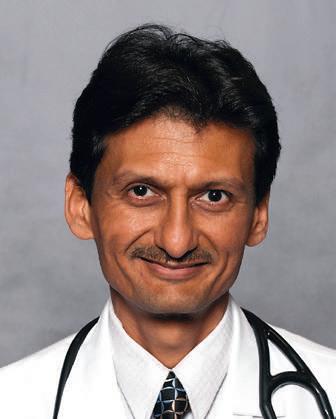
catch heart and vascular conditions in early stages. Left untreated, many conditions progressively worsen. But proactive imaging offers opportunities to correct conditions—
including aortic valve stenosis, mitral valve regurgitation, aortic aneurysm or increased risk of heart disease due to prior cancer treatments—before they become life-threatening problems such as a heart attack or heart failure.
At RWJBH, advanced imaging technologies are being combined with integrated medical records and artificial intelligence to identify, monitor and track cardiac performance through
annual scans. This increasingly helps cardiologists predict the need for interventions, determine treatments and, with patients, develop heart health plans.
“Surveillance of valve diseases, for example, allows us to time valve surgery precisely so that the right patient receives the right treatment at the right moment for the right benefit,” says Ajay Shah, MD, a cardiologist with RWJBarnabas Health Medical Group.
“RWJBH has enormous resources in both advanced technologies and expertise that—combined with pioneering work in artificial intelligence—will have a huge and growing impact on picking up problems much earlier, which will translate to amazing patient care.”
Imaging technologies can save lives, as indicated by patients who have already benefited from proactive scans like these.
How it helps: Measuring electrical activity in the heart can find abnormalities that may indicate conditions such as irregular heartbeat, clogged arteries, heart damage, heart failure or a heart attack.
Great catch: RJ. A then-16-year-old high school football player, RJ discovered through an EKG (administered by an RWJBH screening program for young athletes) that he had an abnormal extra electrical pathway in his heart that could trigger a rapid heart rate. RWJBH electrophysiologists corrected RJ’s condition with a minimally invasive procedure called catheter ablation—and he played his first varsity game just two weeks later.
How it helps: Ultrasound imaging that measures the heart’s size, shape, strength and function can identify problems such as faulty valves,
structural abnormalities, heart attack damage and heart failure.
Great catch: Virginia. She seemed at low risk of heart disease, but Virginia Haines noticed that she often became short of breath during activities such as climbing stairs. A stress echocardiogram— administered while exercising on a treadmill—found she had an obstructed coronary artery. A procedure called an angioplasty opened the blockage and staved off a heart attack.
How it helps: TEE is a type of ultrasound that takes pictures from a position inside a person’s esophagus, close to the heart. Its highly detailed images can help reveal problems such as faulty heart valves.
Great catch: Alex. When his primary care physician heard a heart murmur, Alex Martin went for heart testing. Alex was fit, but a TEE discovered that his heart’s mitral valve was abnormally allowing blood to flow backward. A procedure called mitral valve repair restored Alex’s heart function and installed a durable valve capable of lasting the rest of his life.
How it helps: Artificial intelligence helps create a 3-D model of a patient’s cardiac arteries, providing information that helps cardiologists assess blood flow and the significance of any blockages.
Great catch: Ray. As Director of Information Technology and Services at Monmouth Medical Center (MMC) and MMC Southern Campus (MMCSC), Ray Duarte underwent FFR-CT screening during testing of the technology for its pioneering use at MMCSC. The scan unexpectedly discovered that one of his coronary
arteries was 99 percent blocked. Undergoing a procedure to open the artery brought Ray back from the brink of a heart attack.
How it helps: This type of computerized tomography (CT) scan helps cardiologists learn about the presence, location and extent of calcified plaque in coronary arteries that can lead to a heart attack.
Great catch: Tony. Chest discomfort and pain in his left arm prompted Tony to seek help. When preliminary tests were inconclusive, RWJBH cardiologists ordered a calcium score, the most accurate way to detect potentially dangerous plaque buildups. Tony’s high score indicated he was at high risk of a heart attack—which a proactive bypass surgery helped him avoid.
How it helps: Combining technologies such as stress echocardiograms, CT scans and cardiac magnetic resonance imaging (MRI) lets cardiologists track heart valve anatomy, function and physiology. This helps them monitor abnormalities such as buildups of amyloid proteins that can lead to aortic stenosis and heart failure.
Great catch: Helen. A heart murmur provided the first indication that avid walker Helen Blumenthal had a thick, stiff aortic valve, characteristic of aortic stenosis. Annual echocardiograms helped monitor her condition. When a combination of monitoring and symptoms indicated that the time was ripe for a fix, she underwent a minimally invasive procedure called transaortic valve replacement—and was walking again six hours after surgery.
TO LEARN MORE ABOUT CARDIOVASCULAR IMAGING, SCAN THIS CODE.
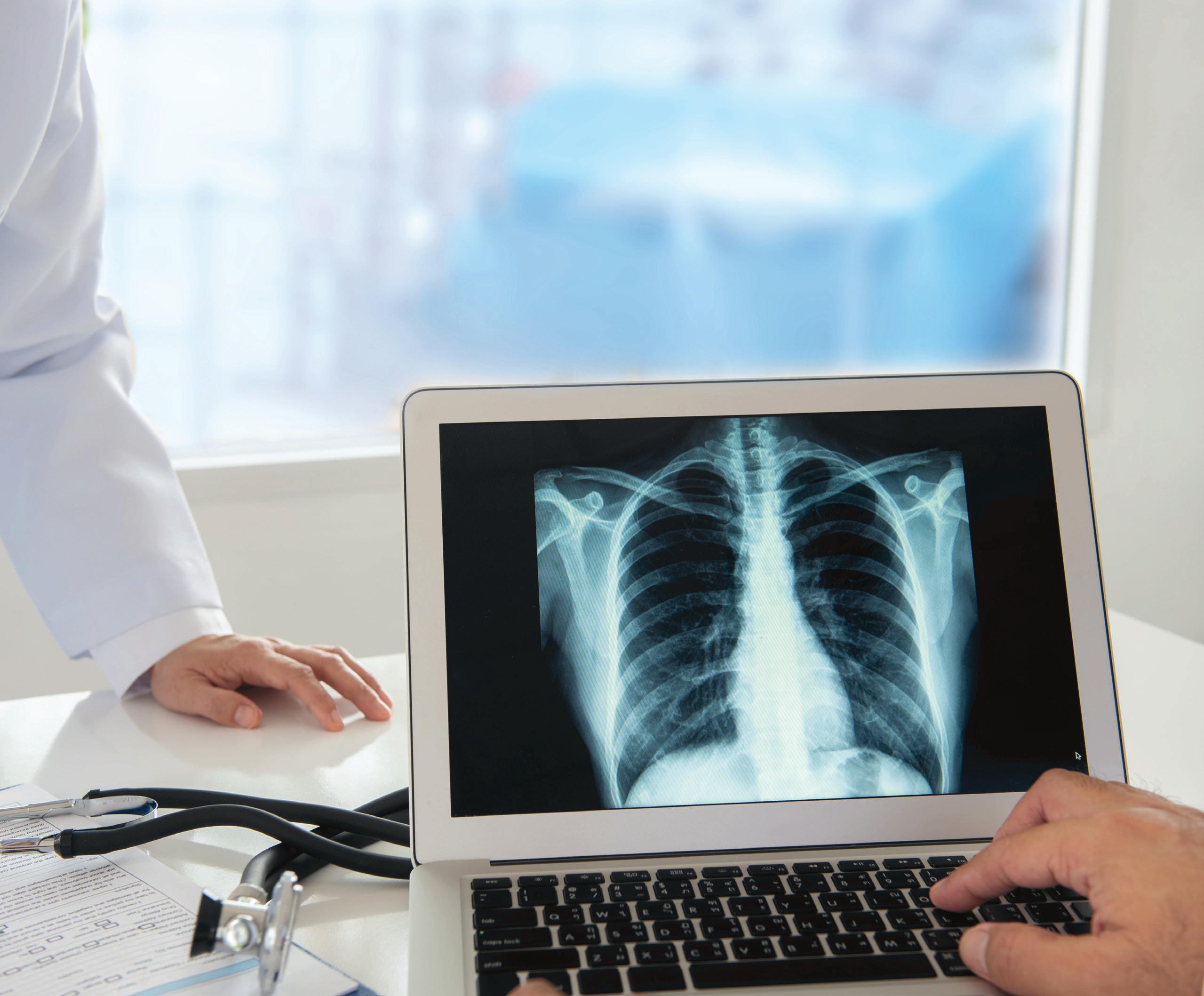


RWJBarnabas Health, in partnership with Rutgers Cancer Institute of New Jersey—the state’s only NCI-Designated Comprehensive Cancer Center—provides close-to-home access to the most advanced treatment options. Call 844.CANCERNJ or visit www.rwjbh.org/beatcancer.
EARLY DETECTION, ADVANCED TECHNOLOGY AND A TEAM APPROACH OFFER IMPROVED OUTCOMES.
Lung cancer is the leading cause of cancer deaths in the United States. The good news: State-ofthe-art early detection, new treatments and sophisticated new technologies— most of which are available across the state at RWJBarnabas Health (RWJBH) and Rutgers Cancer Institute of New Jersey, the state’s only National Cancer Institute-Designated Comprehensive Cancer Center—offer hope for
improving outcomes.
This is the message that Richard Lazzaro, MD, Chief of Thoracic Surgery for the RWJBH Southern Region, wants to spread far and wide. Dr. Lazzaro and his team treat all cancers and diseases of the thorax (chest) area. “Unfortunately, we continue to see many cases related to lung cancer,” he says.
Lung cancer is found early, when it’s most treatable, in just one in four
cancer patients, Dr. Lazzaro explains. “Our thoracic oncology group has a shared goal: to identify more patients with lung cancer at an earlier stage,” he says.
Just as screening can successfully detect breast and colon cancers at early stages, so too can a low-dose computed tomography (LDCT) screening find lung cancer when it is most treatable.
Smokers and former smokers between ages 50 and 80 who meet certain criteria are eligible for the LDCT test. Patients should consult with their primary care physician or find more information at www. USPreventiveServicesTaskForce.org.
“In New Jersey, the vast majority of patients who are eligible for a lung cancer screening don’t get it,” says Dr. Lazzaro. “Patients may not know about the test or may be offered it but not take it because of fear of what they might find out. However, people need to know that we can find lung cancer before a patient has any symptoms. And if we catch it at stage 1, we have a 90 percent cure rate.”
Lung cancer testing most often begins when a patient has troubling symptoms and is referred to a specialist who makes the diagnosis.
At RWJBH, the thoracic oncology team and a broad range of specialists participate in weekly multidisciplinary “tumor boards.” In these meetings, all relevant specialties— such as neurology, interventional pulmonology, interventional radiology, gastroenterology and more—discuss each patient’s case.
Specialists who attend tumor boards come from throughout the RWJBH system as well as from Rutgers Cancer Institute of New Jersey.

“Our goal is to get the patient to the right team for treatment as soon as possible,” says Dr. Lazzaro. “Ultimately, the group comes to
RWJBarnabas Health (RWJBH) offers two highly advanced technologies for the diagnosis and treatment of lung cancer, available at Monmouth Medical Center (MMC).
MMC is one of just two hospitals in New Jersey to have the Ion robot-assisted platform for bronchoscopy, a procedure that lets doctors visualize the inside of a patient’s lungs and airways.
“This is a phenomenal technology,” says Richard Lazzaro, MD, Chief of Thoracic Surgery for the RWJBH Southern Region and a national leader in the field of robotic thoracic surgery. “With Ion, we’re able to take a patient’s CT scan and make a 3-D holographic map. We see the patient’s lungs, trachea, bronchial tubes and any nodules that exist, including those on the surface of the lungs, which a traditional bronchoscopy did not allow us to see.”
MMC is the first hospital in New Jersey to offer the Aliya PEF system, which is used in conjunction with the Ion robot.
The system delivers high-voltage, high-frequency electrical currents that destroy abnormal cells while preserving surrounding healthy tissue. When Aliya PEF is combined with the Ion technology, diagnosis and treatment can occur in the same procedure.
a consensus on the best sequence of treatments for each individual patient.”
Historically, this type of decisionmaking can be a lengthy undertaking as a patient goes from specialist to specialist. “With our multidisciplinary approach, we expedite the process,” Dr. Lazzaro explains. “There are a lot of moving parts, but the approach is sophisticated, well organized, evidencebased and objective.”
Just a few decades ago, treatment for lung cancer was limited to surgery, radiation and certain kinds of chemotherapy.
“Now, since the sequencing of the human genome, there’s a lot more research into identifying mutations in cancers and developing drugs to target those mutations,” Dr. Lazzaro says. “We try to understand what’s going on in the DNA or chromosomes of an individual’s cancer. Is there anything in the
molecular pathology report that tells us if a cancer would benefit from a specific, targeted treatment such as immune therapy, which allows the patient’s immune cells to fight cancer cells?”
Modern cancer treatment often involves a variety of modalities. For example, treatment might begin with minimally invasive robotic surgery, from which the patient can recover relatively quickly and begin a course of chemotherapy or immunotherapy.
Advanced new technologies such as the Ion robot-assisted platform for biopsies and the Aliya PEF system for ablating lung lesions are opening even wider horizons for lung cancer treatment.
“The reality is that lung cancer is common—but lung cancer is beatable,” Dr. Lazzaro says. “We have a team to identify and treat it with the best that medicine has to offer. So don’t be scared. Get your screening; see your doctor. We can help.”
RICHARD LAZZARO, MD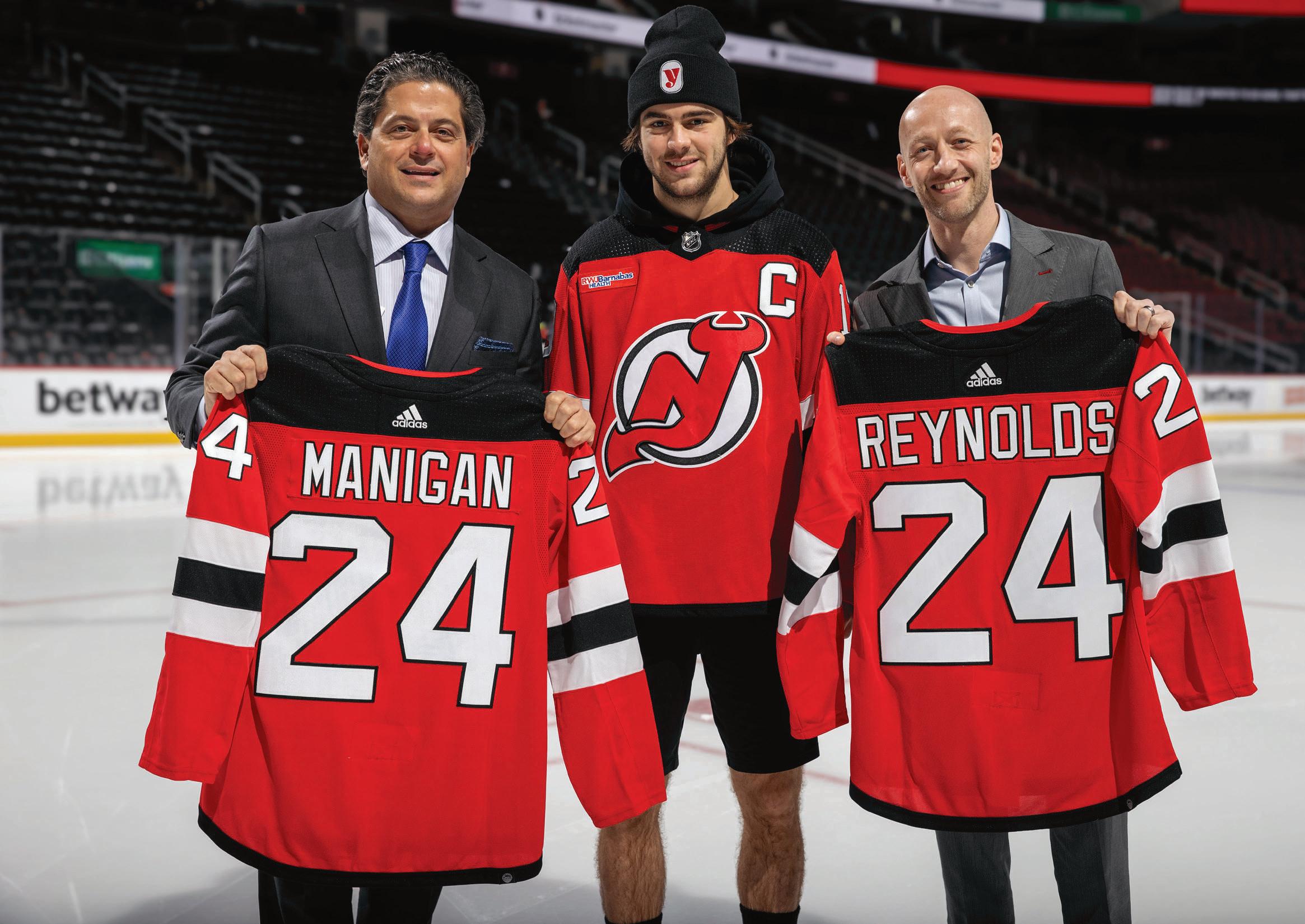
RWJBARNABAS HEALTH AND THE NEW JERSEY DEVILS FORTIFY A LONG-STANDING RELATIONSHIP TO IMPROVE COMMUNITY HEALTH.
Continuing a nearly 30-year association, RWJBarnabas Health (RWJBH) and the New Jersey Devils have jointly announced the multiyear extension of their innovative partnership. The organizations have outlined a multitiered activation plan allowing the two brands to utilize shared resources and strengthen their impact in a shared vision of building healthier communities.
As part of the agreement, the Devils and RWJBH have developed a comprehensive, overarching youth hockey program to engage with children across New Jersey. Touching more than 40 hockey rinks throughout the state as part of the New Jersey Devils Rink
Partners program, this multiplatform initiative is designed to grow the sport of hockey via accessibility, training, on/off-ice skills and the promotion of health and wellness.
The Devils and RWJBH share a commitment to support children from the first day they step onto the ice through their high school years and beyond.
RWJBH has created an educational blueprint that will teach children and their families the importance of leading active, nutritious lifestyles and important injury prevention techniques, all with the goal of encouraging healthy habits at a young age. This is combined with the Devils’ support of coaching,
mental health and athlete care seminars, providing participants with access to NHL-level guidance and education.
“The opportunity to strengthen RWJBarnabas Health’s 30-year partnership with the New Jersey Devils reinforces our shared commitment to improve community health,” says Mark E. Manigan, President and Chief Executive Officer, RWJBH.
Serving as a visual representation of the enhanced collaboration and commitment, RWJBH becomes the team’s first-ever home jersey patch partner, a strategic move designed to strengthen the brand association
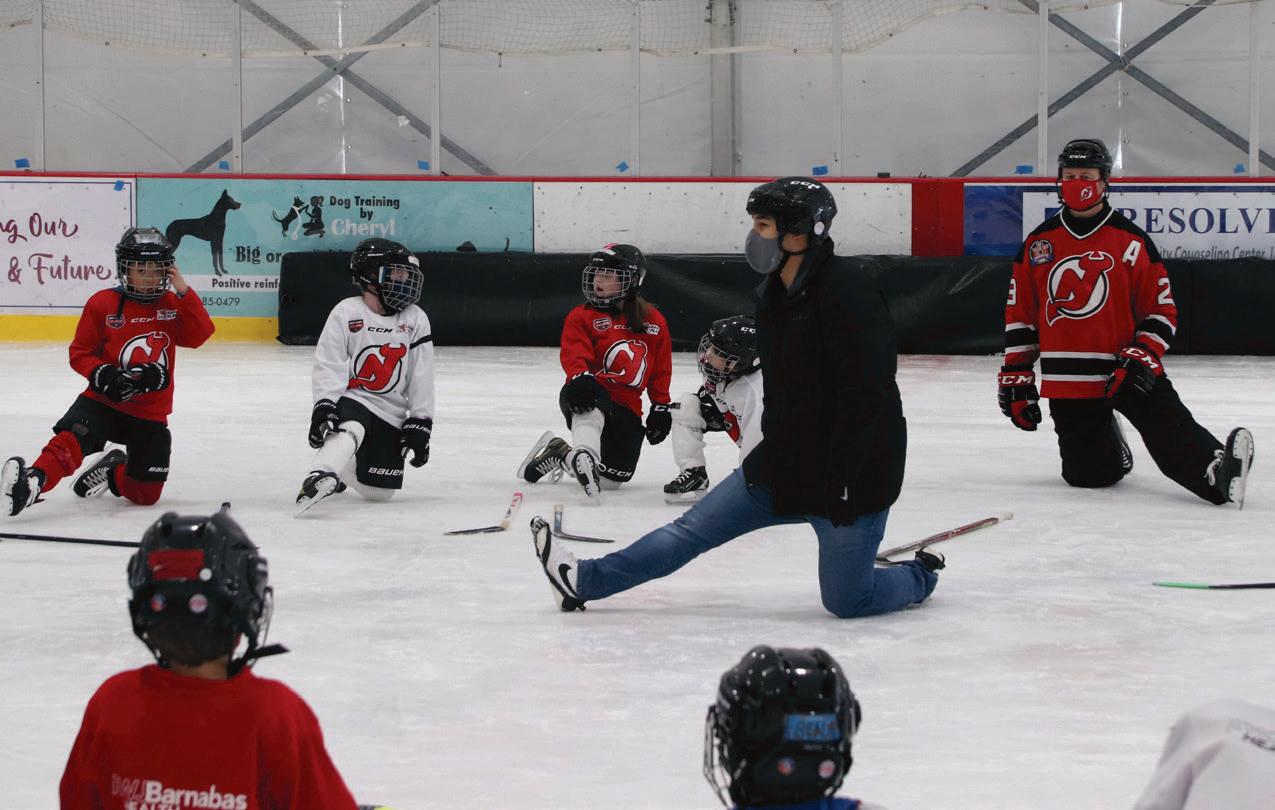
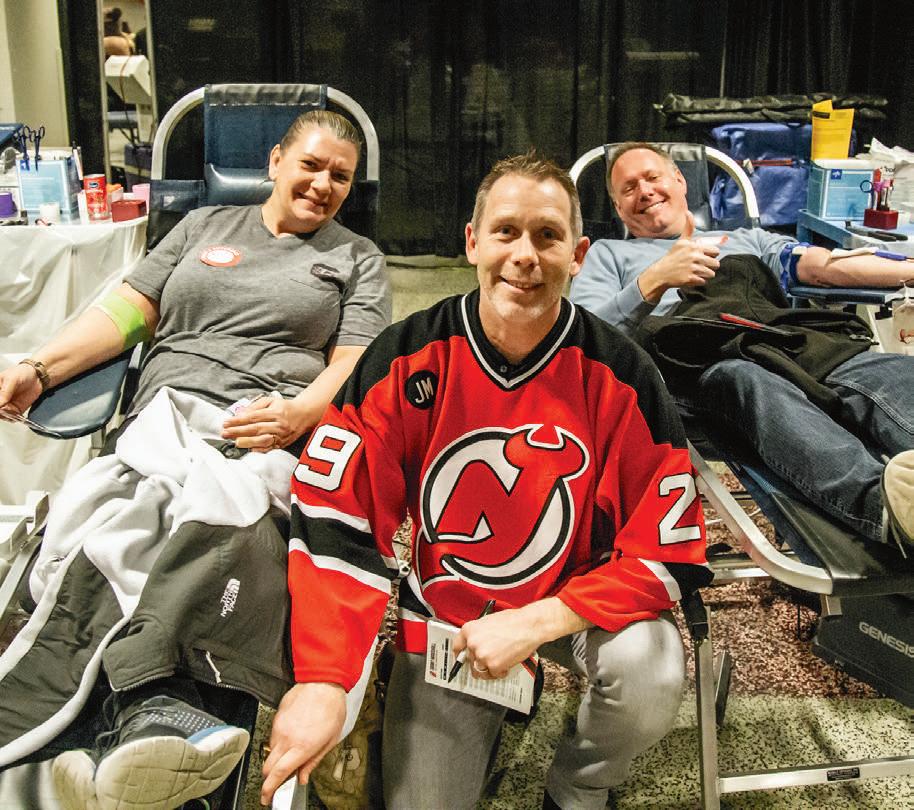
between the organizations. The home jersey branding will be fully integrated throughout RWJBH and Devils activations on and off the ice and throughout the community.
“We are beyond excited to extend our long-standing partnership with the largest academic healthcare system in New Jersey,” says Jake Reynolds, President, New Jersey Devils and Prudential Center.
The agreement also expands RWJBH’s current Devils initiatives, which include:
• Hosting the annual Running with the Devils 5K Run & Walk, offering live and virtual options to promote healthy, active lifestyles
• Supporting youth hockey programs such as Learn to Play and high school hockey
• Continuing to provide support from Devils players, alumni and mascot for community-based programs, including annual systemwide hospital visits designed to lift the spirits of patients and staff during the holiday season
• Hosting annual blood drives, community screenings and important cause nights, along with immersive patient experiences such as the Rock Star program. This VIP gameday experience honors patients and their RWJBH healthcare teams, incorporating elements such as meeting players and in-game recognition
• Continuing to be the presenting partner of the Devils’ annual Hockey
Fights Cancer Night, an opportunity to raise awareness and funds for cancer research and care while honoring a patient/cancer survivor and their healthcare team. To date, funds from this initiative have supported the renovation/enhancement of infusion centers at several hospitals, a new waiting room at The Valerie Fund at Newark Beth Israel Medical Center and the purchase of several vehicles to provide patient and clinical team transportation.
Moreover, the RWJBH Hockey House— located at Prudential Center and the home for youth teams, club teams, high school teams and special events throughout the year—will continue to serve as a primary venue to engage with youth and support community-based health initiatives.
In striving to give Devils players and staff access to the best available supportive athlete care, a dedicated RWJBH physician will serve as the club’s associate provider, working with the club’s athlete care team. The RWJBH network will continue to provide medical testing services including team physicals, imaging, lab work and injury prevention strategies and treatment
to best support players’ fitness while keeping them on the ice and performing at the highest level.
Devils defenseman Dougie Hamilton will also partner with RWJBH to launch Dougie’s Buddies, a community program in which, twice a month throughout the season, Hamilton will host a guest and their family at a Devils home game. The experience includes tickets to the game, food and beverage, Devils merchandise and a postgame meet-and-greet with Hamilton.
“Connecting with our youth is a passion of mine, and it is an honor to partner with RWJBarnabas Health to launch this community program and create a meaningful experience for children and their families,” Hamilton says.
“For 30 years, RWJBarnabas Health and the Devils have been synonymous with the state of New Jersey—longterm partners who care about their communities and giving back together,” says Devils Executive Vice President of Hockey Operations and former Hall of Fame goaltender Martin Brodeur. “There is no better connection to have than with an organization that shares our values, and it’s great for this generation of Devils stars to showcase that on their jerseys.”
To learn more about RWJBarnabas Health programs and services or to find a doctor, visit www.rwjbh.org
RWJBarnabas Health and the Devils collaborate on a variety of initiatives that advance community health goals, including (left) the Learn to Play youth program and (right) blood drives to replenish vital units of lifesaving blood.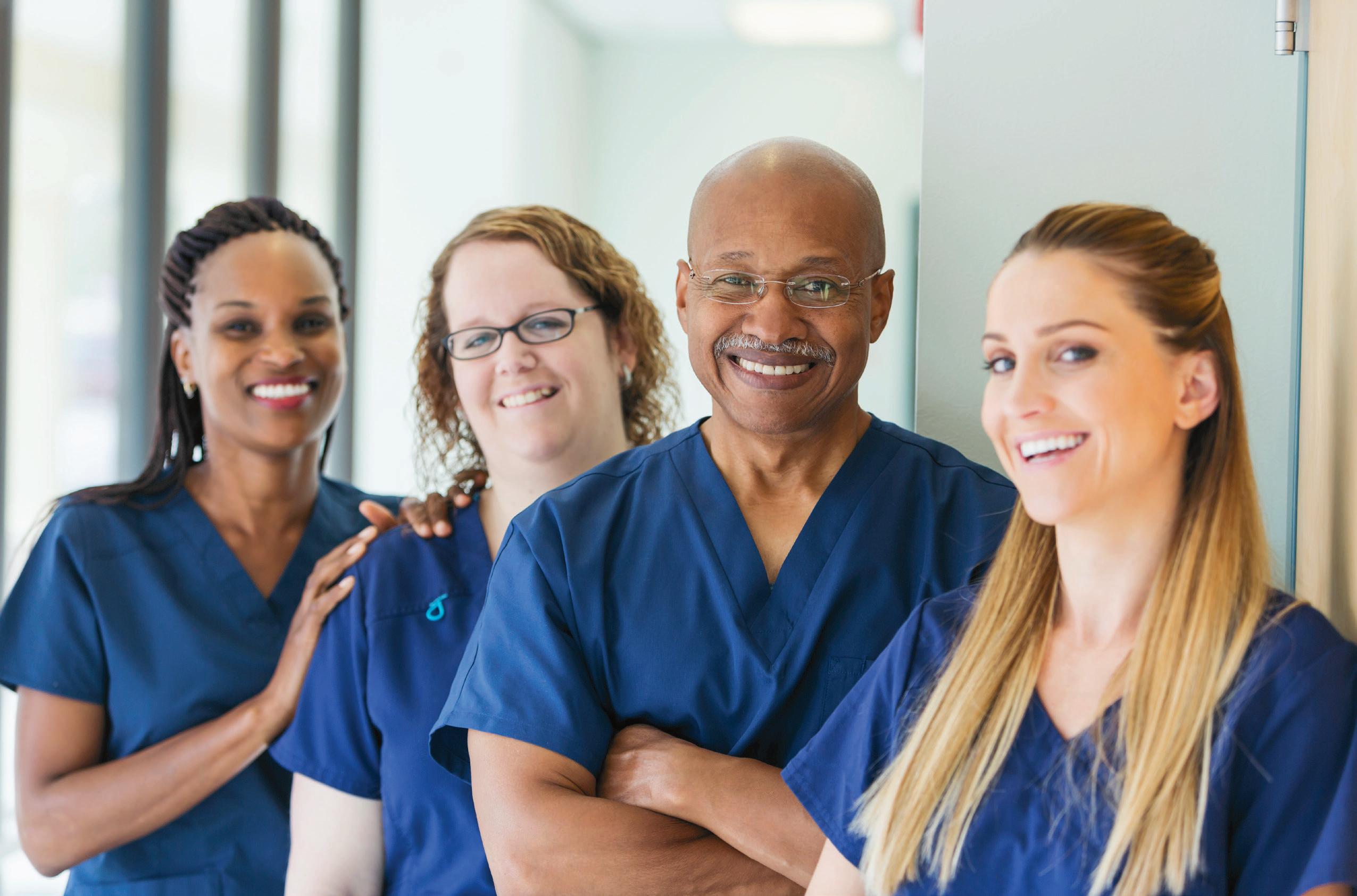
Nursing is said to be the backbone of healthcare. But in both healthcare and humans, the back takes on high stress. It needs to be strong to keep the whole body—or healthcare system—fully functional, resilient and effective. In healthcare, strong nursing ensures good health not just for hospitals and systems but ultimately for patients.
That’s the thinking behind a key framework called RWJBarnabas Health (RWJBH)—The Institute for Nursing Excellence. “Our goal is to build and sustain a nursing workforce that’s representative of the communities we serve through new knowledge and innovations that help improve outcomes for patients and families, reduce costs and provide greater access to care,” says
Nurses who are not only skilled but also engaged and satisfied are more likely to keep practicing, Holecek says. “When you have consistency from highly knowledgeable and competent nurses who have developed as experts in their fields, you have exceptionally good care.”
Nancy Holecek, MAS, MHA, BSN, RN, FNAP, Executive Vice President and Chief Nursing Officer, RWJBH.At The Institute’s core is The Center for Professional Development, Innovation and Research (CPDIR), which is dedicated to ensuring that RWJBH healthcare team members have the resources to excel. Nursing education plays a crucial role in shaping the knowledge, skills and competencies of nurses, which in turn can have a significant impact on patient outcomes. “We believe that nursing excellence is achieved through professional development, upskilling and reskilling,” says Mary Beth Russell, PhD, MA, RN, NPDA-BC, NEA-BC, FNAP, CPHQ, Senior Vice President, The Center for Professional Development, Innovation, Research and The Institute for Nursing Excellence, RWJBH.
The Institute and its mission are supported by The CPDIR, which offers a range of educational programs and initiatives designed to support the professional development of nurses and interprofessional teams at all levels. Through continuous learning and innovation, The Institute is advancing nursing excellence at RWJBH through several key goals:
Professional development teams work at the system level and at each RWJBH hospital to coordinate and conduct consistent orientation programs for nurses and assistive personnel. Teams also provide standardized specialty training for nurses who work in operating rooms, emergency departments, and perinatal and neonatal units, to name a few. Simulation-based education programs enable nurses to rehearse best practices with healthcare professionals so they have firsthand familiarity with clinical methods and situations before caring for real patients.
For recent nursing school graduates, a residency program provides a comprehensive onboarding process throughout the RWJBH system. The
residency program not only facilitates the transition from academic to clinical settings in a collaborative and supportive way but also promotes ongoing professional development. “We’re bridging the gap between the classroom and real-life experience,” Russell says.
RWJBH now conducts regional orientation for nurses in the system’s northern and southern areas to reduce redundancy and promote consistency. “We’re communicating information to new hires in the same way regardless of where they work,” Russell says, adding that this not only encourages reliable practices but also engages nurses. “They enjoy being in the same room with people from all over the system. Not being siloed at their site gives them a macro perspective that’s not just systemwide but also nationwide and interprofessional.”
Nursing is a dynamic profession that constantly evolves with new innovations and research. Keeping up requires updating policies and procedures through reviews of the evidence-based literature in nursing. But it also requires disseminating new information and giving nurses training opportunities to apply it. “We’re actively assessing what we do, applying new information, evaluating and teaching nurses to implement new best practices,” Russell says.
Working with academic partners such as Rutgers School of Nursing and RWJBH’s Trinitas School of Nursing, a designated National League for Nursing Center of Excellence in Nursing Education, The Institute doesn’t just provide graduates with clinical placements but also offers students programs such as externships. Dedicated education units allow a student to work directly with an
RWJBH preceptor (a more experienced clinician) to gain a better sense of what it’s like to work in a given setting. Hired graduates may have an opportunity to begin orientation on a dedicated orientation unit.
Nurses work closely with other professionals. Learning more about what other team members do and enhancing collaboration helps nurses do their own jobs better. “Partnering means having interprofessional discussions not only with physicians but also with people such as physician assistants, advanced practice nurses, dietary professionals and respiratory therapists,” Russell explains. “It also means having discussions with people in nonmedical fields. For example, collaborating with people in professions such as environmental services or engineering could help reduce the risks of patients falling when they get out of bed.”
These measures and others establish RWJBH as a leader in nursing professional development and advancement, Russell says. But helping nurses stay at the top of their game doesn’t just benefit patients and the RWJBH system; it helps nurses themselves.
“When we’re giving nurses opportunities to gain knowledge, build skills, add credentials, align practices, and share evidence and innovations, it lets them know that RWJBH supports them,” she says.
That’s been especially important since the COVID-19 pandemic. “Nursing is different than it was years ago, with high levels of acuity and intensity along with mitigating factors like behavioral health, comorbidities and issues such as long COVID,” she says. “Knowing that they have the resources they’ll need gives nurses a secure feeling. That promotes engagement, which ties in to better patient outcomes. We’re taking nursing to the next level.”
TWO BROTHERS STRENGTHEN THEIR CONNECTION THROUGH THE TRANSPLANT OF A DONATED KIDNEY.
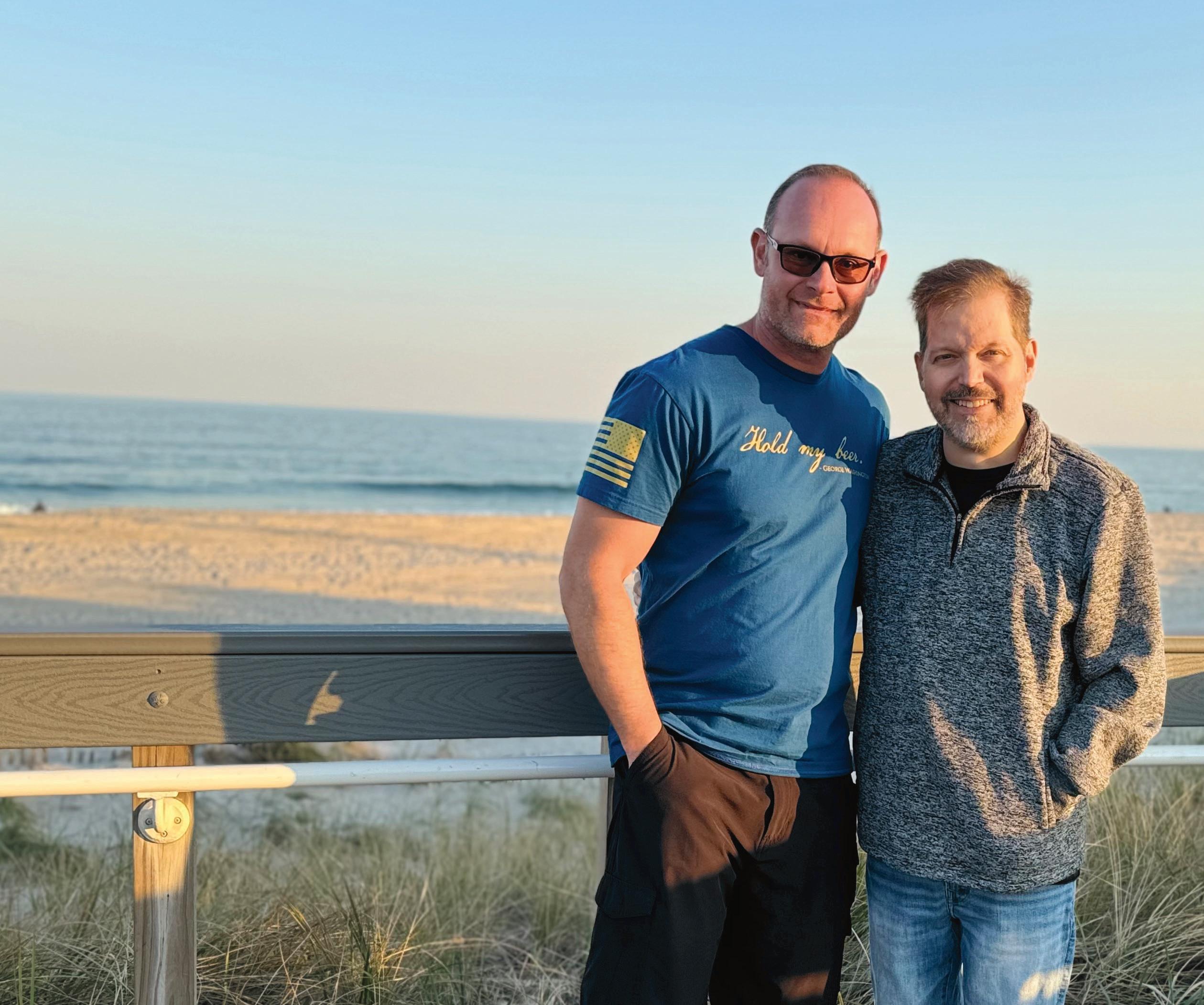
As a firefighter in El Mirage, Arizona, Corey Lydell risks his life to help others every day. So, when his half brother Brian desperately needed a kidney transplant in New
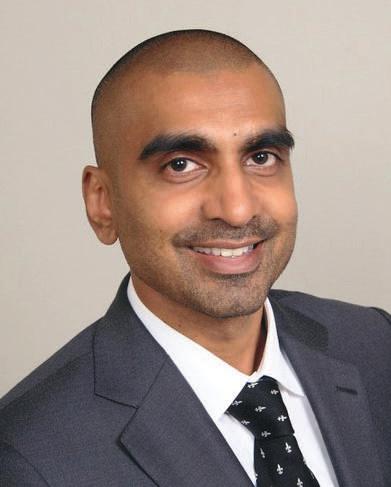
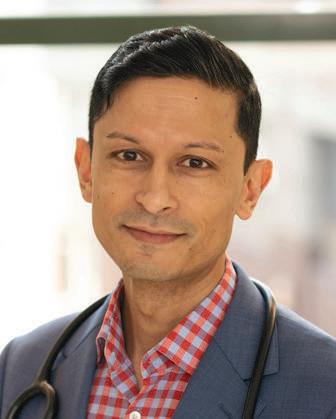
Jersey, Corey didn’t hesitate to act.
“I asked him repeatedly, ‘Are you sure you want to do this?’” Brian recalls. “He said, ‘Absolutely. As a firefighter I put my life on the line for total strangers every day. It would be silly not to do it for my brother.’”
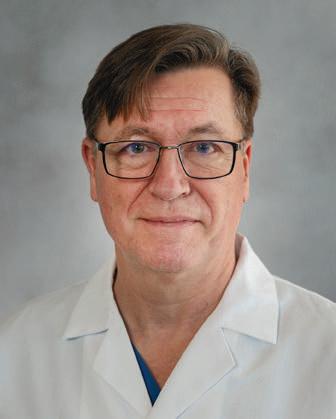
They now share an unbreakable bond through what is often called the ultimate gift.
On November7, 2023, surgeons
with the Robert Wood Johnson University Hospital (RWJUH) Kidney and Pancreas Transplant Program successfully transplanted into Brian a kidney donated by Corey. The surgery was performed by Ronald Pelletier, MD, Surgical Director of Kidney and Pancreas Transplantation for RWJUH, and Advaith Bongu, MD, a transplant surgeon with RWJUH’s program.
The half brothers learned that they could be a match for a living-donor transplant when Brian shared his story with his father and stepmother, who live in Arizona along with Corey.
ADVAITH BONGU, MD SANDESH JAIN, MD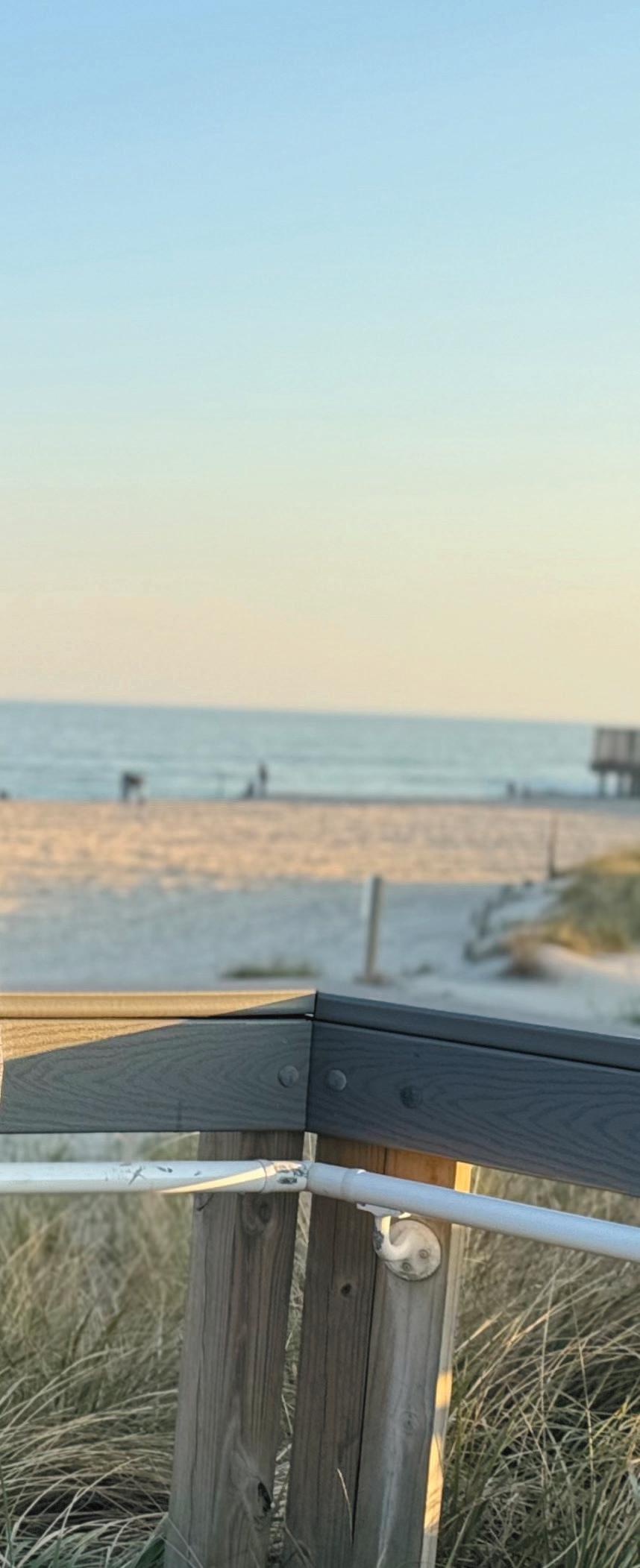
“When I told them that I needed a kidney and that I was an O-negative blood type, they said, ‘We have plenty of O-negative over here,’” Brian says. “I didn’t want to ask them or anyone for a kidney, but the next day, Corey called and said that he wanted to donate.”
The transplant marked the end of a long, difficult journey for Brian. For most of his adult life, he suffered from the effects of ankylosing spondylitis, an inflammatory arthritis that severely
affected large joints throughout his body and required multiple joint replacement surgeries.
Brian’s path to needing a new kidney began when a tumor developed around his fibula. Surgeons removed the tumor, but follow-up scans revealed abnormalities that eventually led to the discovery of a mass on one of Brian’s kidneys. Doctors at Rutgers Cancer Institute of New Jersey, the state’s only NCI-Designated Comprehensive Cancer Center, identified multiple cancerous tumors in one kidney.
One tumor was close to the renal artery and considered unstable, so surgeons were unable to remove it, and the kidney could not be saved. “After surgery, I was fine, but the problem was that my other kidney wasn’t quite waking up,” Brian says.
Brian remained under the care of Sandesh Jain, MD, a nephrologist affiliated with RWJUH in New Brunswick and RWJUH Somerset, who monitored his kidney function closely. The kidney functioned well enough for Brian to avoid dialysis for almost a year. But one day, everything changed.
“I was driving to work and felt like I wanted to die; I felt so ill instantly,” he recalls. “I shook it off in 10 minutes, but I had never felt that way before.”
Brian’s lone functioning kidney was beginning to fail. “It was a very slow decline, but I would have bouts of fogginess and just not feeling right,” Brian says. “Dr. Jain became concerned that I was the type of person who would just keep fighting through this, and then one day, my body would just stop. He recommended that I go on dialysis.”
Once on dialysis, Brian also began the evaluation process for a kidney transplant. The RWJUH team felt he stood a greater chance of finding a match faster if he considered a livingdonor kidney.
People who have kidney failure are encouraged to seek living donors for a kidney transplant because:
• Recipients bypass the wait for a deceased donor’s kidney and receive a kidney faster.
• Dialysis takes a toll on the heart. Receiving a kidney from a living donor can reduce the risk of cardiac complications.
• A living donor’s kidney is less likely to be rejected by the recipient’s immune system than a kidney from a deceased donor.
• Recipients of kidneys from living donors have notably higher success rates and shorter hospital stays, and require less immunosuppression than those who receive kidneys from deceased donors.
• Kidney donation surgery is generally done laparoscopically.
Before donating, Corey talked to a friend who had donated a kidney to his mother and learned about the benefits of living donation.
“It’s family, and I wanted to see Brian have a normal, healthy life so he could be there for his wife and children,” Corey says. “Seeing him get healthy and back to normal— being able to enjoy family time like Thanksgiving dinner again—makes it all worth it.”
It’s difficult for Brian to put into words what Corey’s selfless act means to him.
“I tell him he’s Superman and he can do no wrong,” Brian says. “It’s such a great gesture that it’s hard to put into words and say something that would do it justice. Corey is very low-key. To him, it’s probably enough that he had the satisfaction of seeing me get better. Now, I have to do everything I can to keep this kidney healthy as long as possible. I’m very aware of the sacrifice he made, and I want to make sure that it is honored.”
To learn more about transplants at RWJBarnabas Health, visit www.rwjbh.org/transplant
No one plans heart disease. But everyone have a plan for
Choose the network that handles all aspects of heart health.
From state-of-the-art technology to the most specialized team in New Jersey, our network offers the most complete heart and vascular care. Whether you have hypertension, heart disease or a child a heart issue, our team of nurses, cardiologists heart surgeons deliver comprehensive, compassionate care. Our highly coordinated approach to patient ensures that you can focus on improved health wellness – and get your heart off your mind. Make a plan at rwjbh.org/heart
